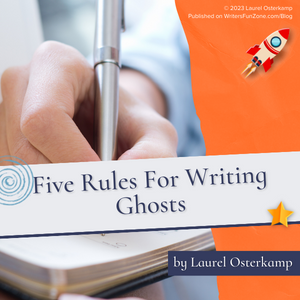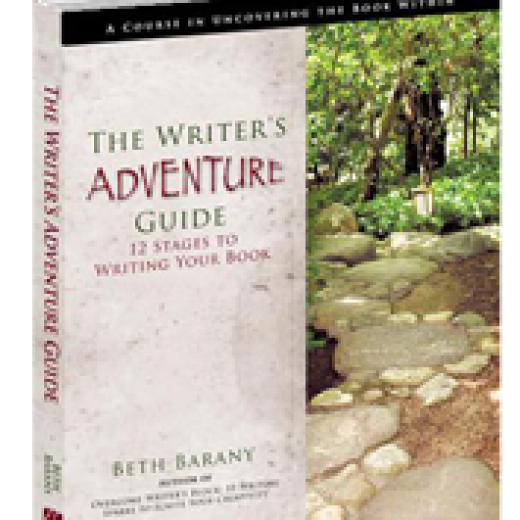Five Rules For Writing Ghosts by Laurel Osterkamp
 Let’s welcome back Laurel Osterkamp as she shares with us “Five Rules For Writing Ghosts.” Enjoy!
Let’s welcome back Laurel Osterkamp as she shares with us “Five Rules For Writing Ghosts.” Enjoy!
***
Autumn is the perfect time for ghost stories. The mystery, intrigue, and spookiness factor is sure to attract readers.
It’s also a great opportunity for writers to let their creativity run wild.
But are there rules we should follow when writing a major character who is a ghost?
Writing ghost characters can be freeing and fun, however, it can also be tricky to pull off in a way that’s both realistic and believable.
Ghost stories can be difficult to write for two reasons: first, it requires a suspension of disbelief on the part of the reader, and second, it requires the author to think outside the box when it comes to how the character interacts with other characters and the environment.
Because my current WIP involves a major character who’s a ghost (and it’s my first time writing a ghost story), I thought I’d research and figure out some ground rules. Here’s what I came up with:
1. Establish a Backstory
With any character you’re going to write, backstory is important. But with a ghost character, that importance is heightened.
Create a history for your ghost, including how they died and why they are still lingering in our world.
It’s also vital to consider the ghost’s motivations.
- Are they stuck in limbo, searching for something they need to resolve?
- Are they seeking revenge?
- Do they want to help someone?
All of these possibilities will help you craft a believable character and create a strong narrative arc.
2. Create a Memorable Character
As authors, whenever we craft a character, we must consider their personality, demeanor, and mannerisms.
Well, this holds true whether your character is alive or dead! Well drawn characteristics will help the reader to identify and relate to the ghost.
For example, if the ghost is seeking revenge, they may have a mischievous streak or a dark sense of humor.
If they’re trying to help someone, they may be wise and compassionate.
Whatever the case may be, it’s important to give the ghost a unique voice and make sure they stand out from the other characters.
3. Use Appropriate Verbs
When writing a ghost character, remember to use language that emphasizes the supernatural.
Avoid using ordinary verbs when describing the ghost’s actions and instead, opt for words that suggest something otherworldly.
For example, instead of saying the ghost “walks” down the hallway, you could say they “glide” or “float.”
Instead of saying they “speak”, maybe they “whisper” or “hiss.”
These small details will help create an immersive atmosphere and make the ghost seem more real.
4. Consider Framing Devices
One device to make sure the ghost character isn’t just a “flat” piece of the story is to use framing devices.
These are techniques that give the ghost character more depth and make them an integral part of the story.
One way to do this is to have other characters interact with the ghost, as this will create more opportunities for the reader to learn about the character.
Additionally, consider using symbolism and metaphors to hint at the ghost’s backstory and motivations.
E. Lockhart’s Family of Liars has excellent examples of framing devices. Carrie’s youngest sister Rosemary drowns and comes back as a ghost, but she only interacts with Carrie.
Their conversations include Rosemary begging Carrie to stay up with her to watch Saturday Night Live, or she’ll sit on her lap, eating potato chips for breakfast, wearing her cheetah costume.
Framing devices like these help the reader to better understand the character and their emotional place in the story.
5. Don’t Overdo It
Finally, remember not to overdo it with the ghost character. It can be easy to get carried away with special effects and supernatural occurrences, but this can take away from the heart of the story.
Instead, focus on creating a believable atmosphere and believable characters. While the ghost character should be integral to the plot, make sure they’re not overshadowing the other characters or taking away from your excellent world building.
These are just a few rules to consider when writing a novel with a ghost character.
By taking the time to craft a believable backstory for your character and using framing devices to give them more depth, you’ll be well on your way to creating a successful novel with a ghost character.
***
About the Author
 Laurel Osterkamp is from Minneapolis, where she teaches and writes like it’s going out of style. Her short fiction has been featured in Abandon Journal, Idle Ink, Tangled Locks Literary Journal, Bright Flash Literary Journal, and The Metawoker, among other places. Her novel Favorite Daughters was released last year by Black Rose Writing, and her new novel, Beautiful Little Furies, will be released in December.
Laurel Osterkamp is from Minneapolis, where she teaches and writes like it’s going out of style. Her short fiction has been featured in Abandon Journal, Idle Ink, Tangled Locks Literary Journal, Bright Flash Literary Journal, and The Metawoker, among other places. Her novel Favorite Daughters was released last year by Black Rose Writing, and her new novel, Beautiful Little Furies, will be released in December.
Social Media:
Website – https://laurellit.com
Facebook – https://www.facebook.com/authorlaurelosterkamp
BookBub – https://www.bookbub.com/profile/laurel-osterkamp
Instagram: Laurel Osterkamp (@laurel_osterkamp) • Instagram photos and videos







sounds really great, will apply them when I write anything about ghosts